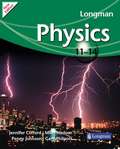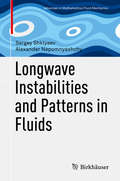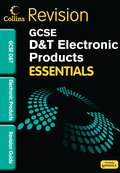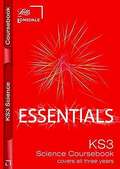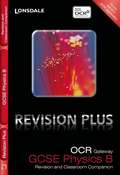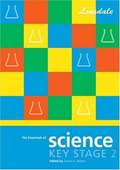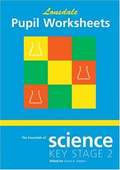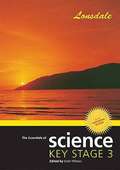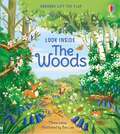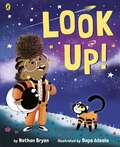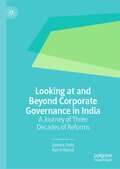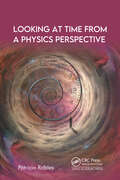- Table View
- List View
Longman Chemistry 11-14 (PDF)
by Richard Grime Iain BrandFully revised and updated according to the specific needs of your high attainers, with appropriate language and content. A wealth of questions in each of the text books challenge, reinforce and consolidate learning. The structures support a condensed two year Key Stage three and are ideal preparation for GCSEs or IGCSE. Practical Resource and Assessment Packs provide teachers with additional support for practical work, assessment, end of unit tests and extension work.
Longman Physics 11-14 (PDF)
by Gary Philpott Penny Johnson Jennifer Clifford Miles HudsonFully revised and updated according to the specific needs of your high attainers, with appropriate language and content. A wealth of questions in each of the text books challenge, reinforce and consolidate learning. The structures support a condensed two year Key Stage three and are ideal preparation for GCSEs or IGCSE. Practical Resource and Assessment Packs provide teachers with additional support for practical work, assessment, end of unit tests and extension work.
Longshot: The Inside Story of the Race for a COVID-19 Vaccine
by David HeathThis is the incredible story of the scientists who created a coronavirus vaccine in record time. In Longshot, investigative journalist David Heath takes readers inside the small group of scientists whose groundbreaking work was once largely dismissed but whose feat will now eclipse the importance of Jonas Salk&’s polio vaccine in medical history. With never-before-reported details, Heath reveals how these scientists overcame countless obstacles to give the world an unprecedented head start when we needed a COVID-19 vaccine. The story really begins in the 1990s, with a series of discoveries that were timed perfectly to prepare us for the worst pandemic since 1918. Readers will meet Katalin Karikó, who made it possible to use messenger RNA in vaccines but struggled for years just to hang on to her job. There&’s also Derrick Rossi, who leveraged Karikó&’s work to found Moderna but was eventually expelled from his company. And then there&’s Barney Graham at the National Institutes of Health, who had a career-long obsession with solving the riddle of why two toddlers died in a vaccine trial in 1966, a tragedy that ultimately led to a critical breakthrough in vaccine science. With both foresight and luck, Graham and these other crucial scientists set the course for a coronavirus vaccine years before COVID-19 emerged in Wuhan, China. The author draws on hundreds of hours of interviews with key players to tell the definitive story about how the race to create the vaccine sparked a revolution in medical science.
Longwave Instabilities and Patterns in Fluids (Advances in Mathematical Fluid Mechanics)
by Sergey Shklyaev Alexander NepomnyashchyThis book summarizes the main advances in the field of nonlinear evolution and pattern formation caused by longwave instabilities in fluids. It will allow readers to master the multiscale asymptotic methods and become familiar with applications of these methods in a variety of physical problems. Longwave instabilities are inherent to a variety of systems in fluid dynamics, geophysics, electrodynamics, biophysics, and many others. The techniques of the derivation of longwave amplitude equations, as well as the analysis of numerous nonlinear equations, are discussed throughout. This book will be of value to researchers and graduate students in applied mathematics, physics, and engineering, in particular within the fields of fluid mechanics, heat and mass transfer theory, and nonlinear dynamics.
Longwave radio and TV reception (SEB contracted)
by RnibThis diagram shows how longwave radio waves and shortwave TV and FM waves' reception are affected by the landscape. There is a key to this page showing the symbol for a house and the different lines that indicate different waves.
Lonsdale Essentials: Revision Guide (PDF)
by VariousWritten for 2009 curriculum change, Essentials provides concise coverage of all the externally assessed course content and skills for GCSE Electronic Products.
Lonsdale Essentials AQA GCSE Additional Science: Revision Guide (PDF)
by Ron Holt Kerry Young Dan EvansAQA GCSE Additional Science Essentials covers all the exam-assessed content on the AQA Additional Science specification. It is designed to help students get the most out of their revision - information is broken down into manageable chunks, key words and phrases are highlighted and higher tier material is clearly differentiated on the page.
Lonsdale Key Stage 3 Essentials - COMPLETE KEY STAGE 3 SCIENCE: Course Book (PDF)
by HarperCollinsA student-friendly approach to KS3 This coursebook covers topics appropriate for the whole of KS3 Science and accurately reflects the language and content of the new Programme of Study. This is a complete version of the individual Years 7, 8 and 9 coursebooks and provides full coverage of the KS3 programme of study.
Lonsdale Revision Plus OCR Gateway GCSE Physics B: Revision and Classroom Companion (PDF)
by Averil MacdonaldOCR Gateway GCSE Physics is carefully matched to the exam board specification for focused study. Clear explanations and supporting diagrams ensure understanding and help students to prepare for the exam with confidence.
Lonsdale Science: Revision Guide (Key Stage 2 Essentials) (PDF)
by Grace A AdamsThis KS2 Science revision guide is for levels 3-5 inclusive and provides a concise summary of the work covered through Years 3-6 and covers all the skills which need to be demonstrated in Key Stage 2 assessments.
Lonsdale Science: Pupil Worksheets (Key Stage 2 Essentials) (PDF)
by Grace A AdamsThese worksheets provide further practice to test and reinforce understanding of the material covered in the KS2 Science Revision Guide.nbsp;
Lonsdale Science Key Stage 3: Revision Guide (PDF)
by Katie WhelanSuitable for levels 3-7 inclusive, this best selling revision guide distils the Programme of Study for KS3 Science down to the essentials, to provide an invaluable recap of all the key topics to strengthen learning and support preparation for tests and assessments.
Look Inside the Woods: (PDF)
by Minna LaceyLook through the trees, see under leaves and discover what's lurking behind the bushes in this beautifully illustrated flap-book. Young nature lovers will enjoy opening the flaps to discover hidden animals and amazing facts. Look out for birds, squirrels, foxes and bears and find out how trees and woods help make our planet a better place to live.
Look Up!
by Nathan Bryon3 ... 2 ... 1 ... LIFT OFF. Let science-mad chatterbox Rocket launch into your hearts in this inspiring picture book from two incredible debut talents.Rocket's going to be the greatest astronaut, star-catcher, space-traveller that has ever lived!But...First, she needs to convince her big brother Jamal to stop looking down at his phone and start LOOKING UP at the stars.----Bursting with energy and passion about space and the natural world, this heart-warming picture book will reignite your desire to turn off those screens and switch on to the outside world.
Look Up: Why Space Is For Everyone... And Why It Matters
by Sarah Cruddas‘Sarah Cruddas is a gifted writer and Look Up is an inspired book. I am hopeful that we will never stop looking up.’ Apollo 11 astronaut Michael Collins
Looking at and Beyond Corporate Governance in India: A Journey of Three Decades of Reforms
by Seema Joshi Ruchi KansilThis book explores theoretical and empirical perspectives on corporate governance and sustainability and reflects upon India’s three decades of corporate governance reforms. It provides a solid base of information culled from extensive empirical research. It will contribute to the 2030 agenda of the United Nations on Sustainable Development Goals by lighting the way forward and enhancing the convergence of corporate governance with sustainability in business entities. Adopting a credible and uniform sustainability reporting framework and cultivating a pervasive “sustainability culture” through effective “sustainability leadership” has become a business imperative. It will be highly relevant for all stakeholders, including shareholders, boards of directors, managers, academicians, and researchers, and it will empower, enrich, and enable them to gain more conceptual clarity and empirical understanding of corporate governance and sustainability issues. In addition, it shows the pathway for policymakers and practitioners to address the myriad challenges that emanate from sustainability by suggesting new approaches emerging in the critical domain of corporate governance.
Looking at it from Asia: The Processes That Shaped The Sources Of History Of Science (Boston Studies in the Philosophy and History of Science #265)
by Karine Chemla Catherine Jami Agathe Keller Christine ProustHow do Documents Become Sources? Perspectives from Asia and Science Florence Bretelle-Establet From Documents to Sources in Historiography The present volume develops a specific type of critical analysis of the written documents that have become historians’ sources. For reasons that will be explained later, the history of science in Asia has been taken as a framework. However, the issue addressed is general in scope. It emerged from reflections on a problem that may seem common to historians: why, among the huge mass of written documents available to historians, some have been well studied while others have been dismissed or ignored? The question of historical sources and their (unequal) use in historiography is not new. Which documents have been used and favored as historical sources by historians has been a key historiographical issue that has occupied a large space in the historical production of the last four decades, in France at least.
Looking at Ribozymes: Biology of Catalytic RNA
by Benoît MasquidaBehind the neologism “ribozymes” lies a family of fascinating molecules, ribo-enzymes, which have been relatively little studied. These catalytically active RNAs are found in all strata of life, from viruses to the human genome. At the end of the 1970s, the discovery of a catalytic RNA nestled in an intron, followed by another involved in the maturation of transfer RNAs, led to the discovery of new ribozymes and the transition from a strictly “proteocentric” vision, inherited from the dogma of molecular biology, to a more “nucleocentric” one. Since then, a variety of ribozymes have been identified in genomes, where their functions often remain mysterious. Looking at Ribozymes traces the discovery of these molecules and presents a picture of their functional diversity, catalytic mechanisms and distribution within the tree of life.
Looking at Ribozymes: Biology of Catalytic RNA
by Benoît MasquidaBehind the neologism “ribozymes” lies a family of fascinating molecules, ribo-enzymes, which have been relatively little studied. These catalytically active RNAs are found in all strata of life, from viruses to the human genome. At the end of the 1970s, the discovery of a catalytic RNA nestled in an intron, followed by another involved in the maturation of transfer RNAs, led to the discovery of new ribozymes and the transition from a strictly “proteocentric” vision, inherited from the dogma of molecular biology, to a more “nucleocentric” one. Since then, a variety of ribozymes have been identified in genomes, where their functions often remain mysterious. Looking at Ribozymes traces the discovery of these molecules and presents a picture of their functional diversity, catalytic mechanisms and distribution within the tree of life.
Looking at Time from a Physics Perspective
by Patricio RoblesThe subject of time continues to be a subject of extensive research in the development of new theories of physics. This new volume is addressed to students who are starting a graduate program in physics or electrical engineering interested in complementing their studies of relativity theory and quantum physics, applying the knowledge they have acquired about these themes to the analysis of situations where the issue of time measurement is relevant. This is the case, for example, of clock synchronization, transit times of optical signals through dielectric and absorbing media, lifetimes of excited atomic states, among others. These topics, in addition to being of great importance to theoretical physicists, are the basis of many technological developments. For example, global positional systems (GPS) are based on the predictions of relativity theory about time and the effect of gravity over time measurement.Divided into six chapters, the volume discusses how the concept of time is present in the main fields of physics, such as classical mechanics, electrodynamics, quantum mechanics and theory of relativity. Illustrative examples and case studies are included in each chapter. The volume includes an analysis of themes related to time such as causality and the arrows of time, spooky action at distance and Einstein-Podolsky-Rosen Paradox, quantum mechanics and entangled states, apparent superluminal velocity, and time reversal.This book, Looking at Time from a Physics Perspective, will contribute to the understanding of concepts learned in courses on classical mechanics, electrodynamics, quantum mechanics and relativity, reviewing the implications of the time variable for the description of the different physical phenomena at the microscopic and macroscopic level.
Looking at Time from a Physics Perspective
by Patricio RoblesThe subject of time continues to be a subject of extensive research in the development of new theories of physics. This new volume is addressed to students who are starting a graduate program in physics or electrical engineering interested in complementing their studies of relativity theory and quantum physics, applying the knowledge they have acquired about these themes to the analysis of situations where the issue of time measurement is relevant. This is the case, for example, of clock synchronization, transit times of optical signals through dielectric and absorbing media, lifetimes of excited atomic states, among others. These topics, in addition to being of great importance to theoretical physicists, are the basis of many technological developments. For example, global positional systems (GPS) are based on the predictions of relativity theory about time and the effect of gravity over time measurement.Divided into six chapters, the volume discusses how the concept of time is present in the main fields of physics, such as classical mechanics, electrodynamics, quantum mechanics and theory of relativity. Illustrative examples and case studies are included in each chapter. The volume includes an analysis of themes related to time such as causality and the arrows of time, spooky action at distance and Einstein-Podolsky-Rosen Paradox, quantum mechanics and entangled states, apparent superluminal velocity, and time reversal.This book, Looking at Time from a Physics Perspective, will contribute to the understanding of concepts learned in courses on classical mechanics, electrodynamics, quantum mechanics and relativity, reviewing the implications of the time variable for the description of the different physical phenomena at the microscopic and macroscopic level.
Looking Back in Crime: What Happened on This Date in Criminal Justice History?
by James O. WindellJust as people are captivated by murder mysteries, detective stories, and legal shows, they are also compulsively interested in the history of criminal justice. Looking Back in Crime: What Happened on This Day in Criminal Justice History? features a treasure trove of important dates and significant events in criminal justice history.Offering hundre
Looking Deep in the Southern Sky: Proceedings of the ESO/Australia Workshop Held at Sydney, Australia, 10–12 December 1997 (ESO Astrophysics Symposia)
by Raffaella Morganti Warrick J. CouchThe idea of a joint ESO / Australia meeting on the large number of exciting new facilities that are, or will soon be, available tihne southern hemisphere arose quite naturally. In the optical and the near-infrared, the Very Large Telescope (VLT) will soon be operational. In the radio, the Australia Telescope Com pact Array is going to be upgraded to higher frequencies (20 and 100 GHz), together with an improvement in very long baseline interferometry (VLBI) facil ities. Other major facilities, such as the Large Millimetre Array and the lkT are being planned. Moreover, new deep surveys are underway in the southern hemi sphere: the southern Hubble Deep Field, the ESO Imaging Survey (BIS), pan oramic deep surveys with the UK Schmidt telescope, and the Anglo-Australian Telescope (AAT) 2dF galaxy/QSO redshift survey in the optical; and the Parkes multibeam HI survey and Molonglo Observatory Synthesis Telescope (MOST) Wide Field continuum survey at radio wavelengths. With all these new facilities, important progress will be made regarding important issues such as the large scale structure of the universe, the very early universe and the associated first epoch of galaxy formation. The generation of large databases, and the oppor tunity for sensitive follow-up observations in complementary wavebands, mean that coordinated radio, infrared and optical projects in the southern hemisphere are likely to become increasingly attractive and important.
Looking for a Few Good Males: Female Choice in Evolutionary Biology (Animals, History, Culture)
by Erika L. MilamWhy do female animals select certain mates, and how do scientists determine the answer? In considering these questions, Erika Lorraine Milam explores the fascinating patterns of experiment and interpretation that emerged as twentieth-century researchers studied sexual selection and female choice. Approaching the topic from both biological and animal-studies perspectives, Milam not only presents a broad history of sexual selection—from Darwin to sociobiology—but also analyzes the animal-human continuum from the perspectives of sex, evolution, and behavior. She asks how social and cultural assumptions influence human-animal research and wonders about the implications of gender on scientific outcomes. Although female choice appears to be a straightforward theoretical concept, the study of sexual selection has been anything but simple. Scientists in the early twentieth century investigated female choice in animals but did so with human social and sexual behavior as their ultimate objective. By the 1940s, evolutionary biologists and population geneticists shifted their focus, studying instead how evolution affected natural animal populations. Two decades later, organismal biologists once again redefined the investigation of sexual selection as sociobiology came to dominate the discipline.Outlining the ever-changing history of this field of study, Milam uncovers lost mid-century research programs and finds that the discipline did not languish in the decades between Darwin’s theory of sexual selection and sociobiology, as observers commonly believed. Rather, population geneticists, ethologists, and organismal biologists alike continued to investigate this important theory throughout the twentieth century.

